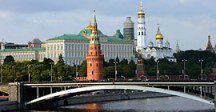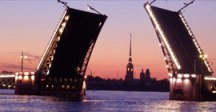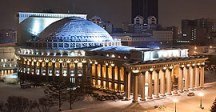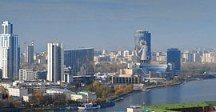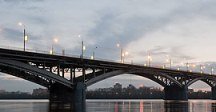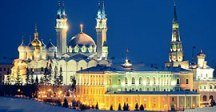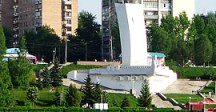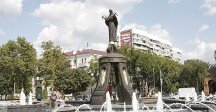Map of Irkutsk
Detailed interactive map of Irkutsk. Map of Irkutsk with streets and numbers of houses. Satellite map of Irkutsk with sights of the city.
The change between the satellite map of Irkutsk and the schematic one is made in the lower left corner of the interactive map.
Irkutsk
Population of Irkutsk: 617,315 people (2021)
Date of foundation of Irkutsk: 1661.
Irkutsk city phone code: +7 3952
Irkutsk automobile area code: 38, 138
Postal code of Irkutsk: 664xxx
Irkutsk is the regional center of the Irkutsk region and is located in Siberia. The city is located along the Angara River at its confluence with the Irkut River. This is a fairly large northern city, whose population has reached 600 thousand people today. A couple of kilometers separate Irkutsk from the most important lake in the world - Baikal.
The history of Irkutsk
Irkutsk was founded as a winter quarters in 1652, during the First Russian colonization of the area. The fortress was built in 1661, and Irkutsk quickly became the main center of the Baikal region and the Russian trade route to China and Mongolia. It acquired the status of a city in 1686. Irkutsk's importance increased after the construction of the Trans-Siberian Railway in 1898.
Irkutsk economy
Modern Irkutsk is one of the largest industrial cities in Siberia and is especially known for a wide range of engineering products. There are railway, aviation, ship repair and automobile workshops here. Other industries include mica processing and consumer goods manufacturing.
The Irkutsk hydroelectric power station on the Angara River is located within the city limits. The Irkutsk reservoir includes Lake Baikal, which was included in the UNESCO World Heritage List in 1996.
The city of Irkutsk, with attractive embankments along the river and many preserved wooden houses on its tree-lined streets, is the administrative and cultural center of Eastern Siberia and the Russian Far East. Irkutsk State University (1918) and the Siberian Branch of the Academy of Sciences are among the numerous research institutes of the city.
The nature that surrounds the city of Irkutsk from all sides is especially attractive. These are pine forests, birch groves and green meadows. Irkutsk is considered the most cultured city in Siberia, as it has a particularly well-developed theatrical and musical spheres. There are also many museums in Irkutsk with rare exhibits collected in them.
One of the symbols of the city is a memorial complex erected in honor of Irkutsk residents who fought during the war. An eternal flame burns in front of the monument, and there is an alley of veterans next to the complex.
What to see in Irkutsk
Historical and Memorial Museum of the Decembrists. In 1825, a group of officers and nobles, who became known as the Decembrists, staged an unsuccessful uprising in St. Petersburg against the autocracy of the emperor.
As a result, many participants were exiled to Siberia, and the first group of Decembrists arrived in Irkutsk in 1826 on their way to a penal camp. After serving their term of hard labor, the leaders of the Decembrists, Prince Sergei Trubetskoy and Prince Sergei Volkonsky, were allowed to settle in Irkutsk.
The Irkutsk History Museum began its life as part of the historical department of the regional museum, which moved into its own building in 2009. Today there are four main expositions: Archeology and ethnography of Irkutsk, Irkutsk in the 17th and 18th centuries, Irkutsk of the 19th century and Irkutsk of the 20th century. They tell in detail about the multinational character of the city and the daily life of its inhabitants over the centuries.
The most famous Catholic church in Irkutsk is the Catholic Church of the Assumption of the Blessed Virgin Mary, which is a protected building located in the historical center of the city. The original church here was built in the middle of the 19th century by the local Polish community, most of whom ended up in Irkutsk as a result of exile for their participation in the Polish uprising of 1830. The current Neo-Gothic version was built as a replacement between 1881 and 1884.
The monument to Emperor Alexander III in Irkutsk was erected in 1908 to commemorate the emperor's decision to build the Trans-Siberian Railway. The monument depicts a statue of the emperor, and the pedestal depicts the governors-General of Eastern Siberia Nikolai Muravyov-Amursky and Mikhail Speransky, as well as the Cossack Ermak, who played a significant role in the conquest of Siberia.
The first church that stood on the site where the Epiphany Cathedral is now located was the church of Saints Peter and Paul, built in 1693 from wood. Then it was located just behind the Epiphany Tower of the Irkutsk Kremlin.
The main memorial of Irkutsk to the fallen during the Second World War is located in front of the administration building of the Irkutsk region and consists of an eternal flame. The flame was lit on May 9, 1975, on the 20th anniversary of the end of the war, using a torch that was itself lit from the eternal flame in Moscow. In 1995, the complex was supplemented by the opening of the Alley of Veterans.
The Irkutsk Church of the Exaltation of the Holy Cross was built between 1747 and 1760 and is one of the most striking examples of the architectural style known as Siberian Baroque, characterized by bright decorations on the facade of the church. The church is also unique to Siberian churches in that its original 19th century interior has been preserved.
On the lower embankment of the Angara River in Irkutsk stands the triumphal arch, known as the Moscow Gate, as it marks the entrance to the city from the European part of Russia. Construction of the gate began in 1811 to commemorate the 10th anniversary of the reign of Emperor Alexander I. In 1858, a second pair of gates similar to the Moscow Gate was erected in the city. They were located in the east of the city and were known as the Amur Gate.
The Irkutsk Regional Museum of Local Lore was founded in 1782 on the initiative of local nobles and merchants and is one of the oldest museums in Siberia. In 1879, the museum was destroyed during the Great Fire in Irkutsk, but reopened in 1888. Today, the museum is divided into two main departments: one dedicated to history and the other to nature, which are located on Karl Marx Street.
The Church of the Savior is the oldest preserved stone building in Irkutsk. The first church that stood on this site, originally located within the walls of the Irkutsk Kremlin, was built of wood in 1672. Work on the modern stone version began in 1706 and was completed in 1710. In the middle of the 18th century, the small cubic church was expanded by the construction of a bell tower.
The Vladimir Sukachev Art Museum of the Irkutsk Region has a separate department, which is the only art museum entirely dedicated to Siberian art. The museum displays Siberian works of art from ancient times to the present day, including idols, icons, wooden sculptures, paintings and porcelain objects. The museum is located in the late 19th century mansion of a former merchant and gold miner.
The Church of St. Charalambos is also known as the Church of the Archangel Michael, as it is dedicated to both saints. The original version was built of wood in 1738, but in 1777 it was replaced by stone, which has survived to the present day. Traditionally, the church was used to bless sailors before sailing.
Trinity Church is one of the oldest surviving churches in Irkutsk. It was built in the second half of the 18th century and consecrated in 1778. In Soviet times, the church was used as a planetarium. Right next to this church is the smaller and simpler church of St. Gregory of Neo-Caesarea, which dates back to 1805 and was built in the classical style.
At the intersection of Lenin and Karl Marx streets stands the main statue of Vladimir Lenin in Irkutsk. The monument was opened in 1952 and is the work of sculptor Nikolai Tomsky. The statue is actually a copy of an earlier statue of Tomsky, which still stands in the city of Voronezh. There are also several other Lenin statues throughout the city.
The Art Museum of the Irkutsk region named after Vladimir Sukachev on Lenin Street. It is believed that the Irkutsk Art Museum was founded in 1870, when local collector and philanthropist Vladimir Sukachev acquired the first painting, but the collection, housed in Sukachev's own estate, was opened to the public only in the 1880s - becoming the first gallery in Siberia. At the beginning of the 20th century, construction began on a special building to house the collection, and in 1920 the collection became part of the city regional museum.
Monument to Admiral Alexander Kolchak on Angarsk Street. Admiral Alexander Kolchak was an outstanding leader of the white forces during the Russian Civil War, who was even briefly declared the supreme ruler of Russia. Kolchak ended his days in Irkutsk. This monument to a controversial figure in Russian history was unveiled in 2004 to mark the 130th anniversary of his birth.
The Prince Vladimir Monastery is dedicated to the Russian Holy Prince Vladimir, who was created with the conversion of Russia to Orthodoxy. The monastery was founded in 1888 on the 900th anniversary of the adoption of Orthodoxy by Russia. Its main church is the beautiful St. Vladimir's Church, which was built between 1888 and 1895.
The Znamensky Convent of Irkutsk was first mentioned in 1689. At that time, its buildings were entirely built of wood, and the first stone buildings appeared only in the middle of the 18th century. The construction of the main church of the Sign of the Blessed Virgin Mary began in 1757 and was completed in 1762.
Transport in Irkutsk
Irkutsk is the starting point for most trips to Lake Baikal - it is the closest international transport hub to the lake, connecting it not only with Moscow, but also with St. Petersburg, Novosibirsk or Krasnoyarsk by air and dozens of other cities by train.
Listvyanka, the nearest settlement to the lake and the starting point of the Circum-Baikal Railway, is only 70 km from Irkutsk, and the must-visit island of Olkhon is 270 km from the city.
Irkutsk Railway Station, known as Irkutsk - Passazhirsky, is located in a historic building built in 1897 on the banks of the Angara River opposite the historic city center. To get from the station to the central Lenin Street, take tram No. 1 or bus No. 77 or 80. The train station is about 2 km from the center, you can just walk along the river and cross the bridge, and you are almost there.
Irkutsk Railway Station is one of the largest on the Trans-Siberian railway, almost all trains on this route stop here.
Irkutsk Suburban railway Station is located in the same building and serves trains to Slyudyanka, Baikalsk, Winter, Bolshoy Luga, Glubokoe. Station address: Chelnokova str., 1.
Popular Russian destinations: Moscow, Kazan, Ulan-Ude, Vladivostok, Chelyabinsk, Kislovodsk, Severobaikalsk, Novosibirsk. Popular international destinations: Beijing, Ulaanbaatar, Harbin, Manchuria.
Irkutsk bus station is located quite close to the city center, about 1 km from the central market (tram No. 4) and 6 km from the railway station. The bus station mainly serves regional routes, but also a few more remote ones.
For many travelers, the Irkutsk bus station is the starting point for exploring Lake Baikal - from here you can get to Olkhon Island, Listvyanka, Slyudyanka, Arshan and Ulan-Ude. There are only a few buses a day to each destination. The address of the bus station is 11 Oktyabrskaya Revolyutsii Street.
Irkutsk river port. The main passenger river port, from where you can start your journey along the Angara River or discover Lake Baikal, is called Raketa. This river port is located 7 km from the city center in the Sunny district of Irkutsk. To get here from the railway station, take the minibus No. 16, which goes along Lenin Street.
Summer walks: Irkutsk - Listvyanka (1 hour), Irkutsk - Taltsy (35 minutes), Irkutsk - Port Baikal (1:25), Irkutsk - Olkhon Island (Khuzhir) (8 hours), Irkutsk - Ust-Barguzin (11 hours), Irkutsk - Severobaikalsk (12 hours), Irkutsk - Bratsk (12 hours), Irkutsk - Big Cats (4 hours). The address of the river port is 98B Zhukov Avenue.
Irkutsk International Airport is located very close to the city center - just 5 km away. from Irkutsk bus station. There are two terminals here - one for domestic flights and the other for international flights. You can get here from the railway station by minibus No. 20 or 94 or from the central Kirov Square by trolleybus No. 4, which runs along the central Karl Marx Street and Lenin Avenue. Airport address: 13 Shiryamova street.
Popular destinations in Russia: Moscow, St. Petersburg, Novosibirsk, Krasnoyarsk, Ulan-Ude. International destinations: Ulaanbaatar and Harbin.
Since Irkutsk is located on the Trans-Siberian Railway, you can get here on almost any train heading to Vladivostok, Khabarovsk, Ulan-Ude, Ulaanbaatar or Beijing. In Moscow, trains depart from Yaroslavsky Railway Station. The city is well connected with Moscow - about 8 flights are operated daily from three Moscow airports.
Irkutsk sights
Moscow Triumphal Arch, Kazan Church, Catholic Church, Znamensky Monastery, Labor Square, Babr Sculpture, Botanical Garden, Folk Drama Theater, TYUZ. Vampilova, Icebreaker-Angara Museum, Art Museum, Volkonsky House, Museum of Mineralogy, Musical Theater, Cathedral of the Epiphany, Cathedral of the Immaculate Heart of the Mother of God, Amur Gate, Shubin House.
The largest cities in Russia:
2024 © Russia-Karta.ru
